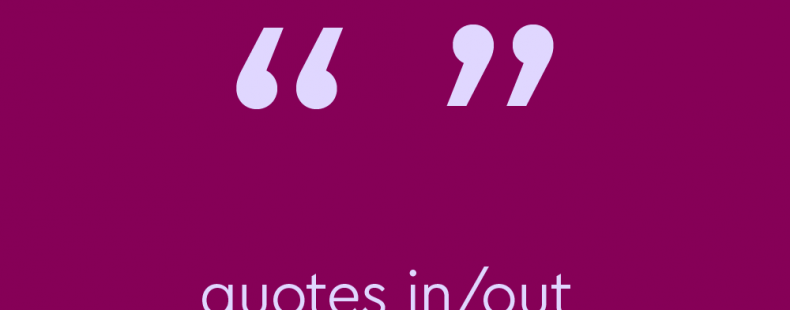Ensuring your sentences have proper punctuation can be tough, even when you are only dealing with one punctuation mark. We often have our hands full dealing with just a single colon, semicolon, or—heaven forbid—a comma. So you might find yourself frazzled upon adding quotation marks to what’s already a heavily punctuated sentence. Before you panic, you can use this quick guide to help you keep those quotation marks from jumbling up your perfect punctuation.
When to use punctuation inside quotation marks
Before we get too complicated, it might help to briefly review what quotation marks are. We have an awesome guide to quotation marks if you need an in-detail refresher. Quotation marks are a pair of punctuation marks used to set off quotations, which are selections of text or speech said by someone besides the writer or speaker.
Now, let’s look at the instances that typically call for punctuation inside quotation marks.
1. Periods and commas
In American English, a quote that comes at the end of a sentence will contain a period inside the final quotation marks.
✅ Correct: She said, “Goodbye.”
❌ Incorrect: She said, “Goodbye”.
If a sentence ends with multiple quotes (a quote within a quote), the period is placed within all of the final quotation marks.
✅ Correct: The witness said, “I heard the man say, ‘Don’t move.’”
❌ Incorrect: The witness said, “I heard the man say, ‘Don’t move’.”
If a quote ends in the middle of a sentence, we typically put a comma rather than a period at the end of the quote inside the quotation marks.
✅ Correct: “The house is haunted,” said the creepy undertaker.
❌ Incorrect: “The house is haunted”, said the creepy undertaker.
2. Question marks and exclamation points
If a quotation is a question, but the main sentence is not, we typically place the question mark inside the final quotation marks. In this case, you don’t also need a period to end the sentence.
✅ Correct: She looked at me and asked, “What is your name?”
❌ Incorrect: She looked at me and asked, “What is your name”?
If both the quote and the sentence are questions, you only need a single question mark inside the quotation marks to end both the quote and the sentence.
✅ Correct: Who asked, “Are we there yet?”
❌ Incorrect: Who asked, “Are we there yet?”?
The same rules are typically used for exclamation points: use a single exclamation inside the quotation marks if the quote itself is an exclamation or both the quote and the sentence are exclamations.
✅ Correct: He shouted, “Hooray!”
❌ Incorrect: He shouted, “Hooray”!
When to use punctuation outside of quotation marks
Now, let’s look at the instances that use punctuation outside of the quotation marks.
1. British English
In British English, periods and commas only go inside quotation marks if the original quoted material also had those punctuation marks. Unlike American English, British English only uses single quotation marks ( ‘ and ’ rather than “ and ”) for direct quotes. For example,
Original text: I found a cherry pie by the window sill.
Period: He wrote, ‘I found a cherry pie’. (The original text didn’t have a period in it.)
Comma: He wrote, ‘I found a cherry pie’, which seems to suggest he ate it. (The original text didn’t have a comma in it.)
2. Commas introducing quotes
When introducing a quote, we typically place a comma between the quote and the phrase leading into it. Style guides may differ on whether this comma is actually necessary, but if it is used, it is advised to put it outside and before the quote.
- The butcher said, “No ham today.”
Typically, we still follow this rule if a quote is split apart in a sentence.
- “Without a doubt,” the zookeeper said, “they were hungry, hungry hippos.”
3. Colons, semicolons, and dashes
Typically, these three punctuation marks all go outside of quotation marks. The exception to this general rule is when the quoted material originally used one of these punctuation marks.
Examples
Colon: My mom always told me a good piece of advice: “Don’t poke a wasp’s nest.”
Semicolon: The guide said, “Don’t panic”; we panicked anyway.
Dashes: “I will make the argument”—the prosecutor cleared her throat—”that the theft was planned from the very beginning.”
2. Question marks and exclamation points
If a sentence is a question or an exclamation, but the quote is not, we typically place the punctuation mark outside of the quotation marks.
Question mark: How many times are you going to say “I told you so”? (“I told you so” is not a question, but the main sentence is asking a question.)
Exclamation point: Even though the building was on fire, Nicole said it was “no big deal”! (Nicole’s statement was not an exclamation, but the main sentence is.)
Are you ready to quiz yourself on how to use quotation marks now?
Punctuate perfectly with Grammar Coach™
Confused about punctuation and its proper use? The Thesaurus.com Grammar Coach™ platform makes writing papers, essays, emails, and a whole lot more a whole lot easier. This writing tool uses machine-learning technology uniquely designed to catch grammar as well as spelling errors. Its Synonym Swap will find the best nouns, adjectives, and more to help say what you really mean, guiding you toward clearer, stronger, writing.















